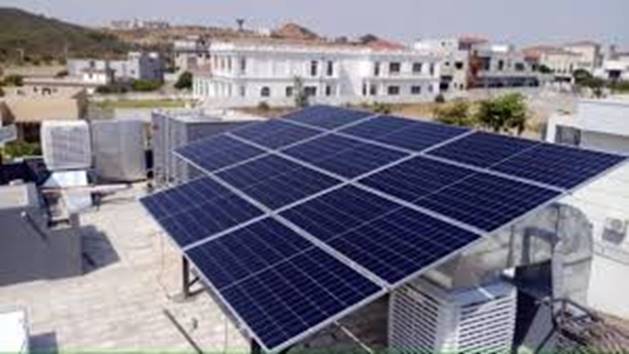
In the first six months of 2024, Pakistan imported 13 gigawatts of solar panels from China. Solar only works during the day, but that still is a huge addition to Pakistan’s power supply and it allows families to run air conditioners during the summer daytime heat
Positive Signs for the Pak Economy
By Nayyer Ali MD
September 23, 2024

After a crushing two-year economic downturn that began in mid-2022, the Pakistani economy is starting to mend, perhaps setting the stage for the sustained high levels of economic growth needed to become a middle-income country, and eventually a developed economy.
The prime reason for the last two years of poor economic performance has been massive inflation that peaked at an annual rate of over 30%. This was brought on by the bizarre economic policies of the current government that was trying to goose the economy ahead of the most recent elections. The hope was that a strong economy would blunt the vote for the PTI and Imran Khan. That strategy failed both politically and economically.
On an economic level, what happened was massive inflation and a flood of imports that put the current account balance (essentially the trade deficit after accounting for remittance income) deeply in the red. Pakistan was faced with an economic crisis as it was running out of dollars to cover the import bill and had to turn once again to the IMF for a bailout. The price of that bailout was the IMF demanded Pakistan get control of inflation and decrease its imports to a level that could be paid for by exports and remittances.
To accomplish this the government placed a variety of controls on imports, many of which hurt exporters that depended on imports to produce goods for export. More importantly, the State Bank of Pakistan (SBP) put up interest rates to over 20% to quash domestic demand and reduce inflation. It has left rates up over 20% for about two years, and finally, we are getting a slowdown in inflation. But rates that high crush economic activity as both businesses and consumers have a difficult time financing purchases with interest rates so high.
In August 2024 annual inflation finally dropped to below 10%. Measured over the last six months, inflation is only running at about a 5% annual rate, and prices for example only rose 0.4% in August on a monthly basis. The SBP has responded by lowering interest rates a few points, but they remain at a punishingly high level of around 19%. Given the marked slowdown in inflation, the SBP should dramatically lower interest rates in the coming months. Lower rates will greatly stimulate domestic demand and business investment and move growth higher. Already, stock investors are anticipating an upturn, with the KSE-100 index surging from 45,000 to 80,000 in the last 12 months.
In addition to lowering rates, the SBP should maintain the exchange rate on a freely tradeable basis rather than fixing it to a certain level. In fact, the SBP should have a policy of keeping the exchange rate somewhat undervalued with respect to the dollar. A cheap currency acts as a stimulus to exporters, making their products cheap to sell in dollars, while holding a lid on imports by making them relatively expensive for Pakistanis to buy. An overvalued fixed exchange rate was the primary reason Pakistani exports failed to grow much in the 2010s.
Another positive sign for Pakistan is in the energy sector. Electricity has been a headache for the country for thirty years. The main problem is the terrible terms signed with the IPPs (Independent Power Producers). The IPPs were given terms that required the government to pay them in dollars for the power capacity they had, whether it was being used or not. Often the plants were idle but the bills kept adding up, resulting in unpaid “circular debt”. The consequence of all this is that retail electricity is more expensive in Pakistan compared with India or Bangladesh. But in the last year, a remarkable event has happened to change the power dynamic in the country. Consumers have bought massive numbers of cheap solar panels from China. In the first six months of 2024, Pakistan imported 13 gigawatts of solar panels from China. Solar only works during the day, but that still is a huge addition to Pakistan’s power supply and it allows families to run air conditioners during the summer daytime heat. This made Pakistan the third largest buyer of solar panels from China, and for comparison, Britain only installed one gigawatt of solar in the first half of 2024. The 13 gigawatts represents 25% of Pakistan’s current electric power capacity so it is a massive addition. At this pace Pakistan could install 75 gigawatts of solar in only three years.
One big issue with the consumer purchase of solar panels is what is called “net metering”. The panels generate more power than the owner uses during the day, and the rest can be sold back to the power grid. The question is what price should that electricity be sold at, the retail price that consumers pay for power or the wholesale price that the power companies pay to generate their power? Consumers want the retail price because it is much higher, while the power companies want the wholesale price. This could turn into a real tussle as the amount of solar soars. This retail buying of solar by consumers doesn’t even account for what the power companies could install if they wanted to invest in solar. Pakistan is solar-rich, with plenty of sunshine year round, especially in Baluchistan.
Another bright spot for Pakistan is the agricultural sector. While overall growth in fiscal 2024 was tepid, agriculture soared ahead at over 6% growth. Pakistani farms continue to produce bumper crops of grains, cotton, sugar cane, while livestock is expanding. Milk production is massive and a good source of high-quality animal protein for the population.
Water is another positive sign for Pakistan. The country experienced serious flooding in Sindh and Baluchistan last year when the monsoon was more intense and extensive than expected. However, this may not have been a fluke. With the global climate warming 1.2 degrees centigrade over pre-industrial levels, one effect appears to be a strengthening of the Indian Monsoon. Scientists are now projecting that the increase may permanently improve rainfall across Pakistan. Appropriate dams and other water management techniques will need to be implemented to control the increase in rainfall without causing widespread flooding, but overall more rain will be a blessing for a country that is for the most part rather arid.
Despite a rather up-and-down economy over the last 15 years, where do Pakistanis stand in terms of standard of living? Compared to peers in India and Bangladesh, how poor or rich are Pakistanis? The best source for comparing countries is the ICP (International Comparison Program) run by the World Bank. Every five years they do extensive field work around the world to understand and develop the price levels in each country. This means understanding how much does 280 rupees buy in Pakistan compared to 1 dollar in the US? Because many goods and services are much cheaper in Pakistan, even though on the currency market 280 rupees equals one dollar, the average Pakistani can buy much more in Pakistan with 280 rupees than an American can buy with a dollar in the US. This creates what is called a PPP (Purchasing Power Parity) exchange rate, and allows one to properly compare the living standards of different countries with different currencies.
The latest ICP was based on data collected in 2021. Using Actual Individual Consumption (AIC), we can see what the actual standard of living is in each country. For the US, it was 52,600 dollars in PPP terms. China was at 9,286 dollars. Pakistan was at 6,022 dollars, while India was at 5,745 and Bangladesh was 5,707. These numbers are validated when we look at how many cars and motorbikes per one thousand persons are owned in each country. For India in 2024, the number was 57, but Pakistan was already at 69 in 2021, and has climbed since then. Another factor to keep in mind is the extreme inequality, both social and economic, that plagues India. While India’s per capita AIC is not much less than Pakistan’s, Pakistan has a broader middle class and less abject poverty than India.
Pakistan may, in fact, be doing better than the World Bank data. Pakistan published its first rebasing of its GDP statistics in 2022 after over a decade of not updating its economic database. This rebasing was only to a new base year of 2016, but still showed Pakistan’s actual GDP was 27% higher than thought. If we were to rebase to 2023, we would find a further boost of perhaps 5-10% of GDP.
Pakistan is still a poor country, and one of its main impediments to growth is chronic underinvestment and inadequate savings. Good economic management would make addressing that shortcoming a priority.
Two other areas desperately need attention. One factor holding back Pakistan is the low rate of women in the workforce. Pakistan needs to put more of its women to work to lift its economy, both in skilled professions and in export-oriented manufacturing like textiles and other light goods. Second, Pakistan needs to invest in its human resources. It needs to make sure that every child gets at least eight years of a quality basic education, and that as many students as possible go on to high school and university.
Pakistan has the ability to reach a developed living standard (GDP per capita of about 25,000 dollars) within 25 years. But to do that it must sustain economic growth rates of 6-7% annually. That is absolutely achievable with good economic management. The current finance minister, Muhammad Aurangzeb is a high-quality technocrat, and if the politicians stay out of his way, Pakistan’s economy should enjoy a strong rebound in the next 18 months.

